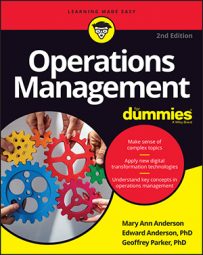Risk is a situation involving exposure to danger. Let’s face it: In life, risk is everywhere. In business, there are several types of risks you should be aware of and actions you can take to prevent the danger or protect yourself from it.
Types of business risk
As an operations manager, you’re likely to encounter the following risks, which can prove devastating to your business.
Demand risks: Nothing is more detrimental to your business than not meeting projected sales targets. Many things can cause demand risk, including not really knowing who your customers are or what they require, or not assessing your competition and those companies’ ability to meet customer requirements.
The good news is that you can minimize and manage demand risk. The place to start is with an accurate forecast, which can help you plan your capacity and inventory levels. By maintaining excess capacity, you can always produce more if demand is higher than expected. You can also carry inventory to satisfy the customers’ appetite on demand.
Technological risks: Things don’t always work as expected, especially when new technology is involved. Technology risk can be present in many ways. A specific technology may look promising early in the research and development stage, and a firm may invest significant time and resources to further develop it, only to find that the technology doesn’t deliver the functionality that was hoped for.
There’s also the risk that, although the technology performs well in laboratory conditions, it may not perform as specified after it’s incorporated into a product, or it may not satisfy what the customer actually wants.
Financial risks: How to price a product is one of the riskiest decisions you can make. Price your product too high and you risk losing sales; price your product too low and you risk losing revenue. You also face significant risk in procuring the supplies and labor needed to produce and sell the product. Global businesses also have the issue of managing currency exchange rates, which fluctuate continuously.
Organizational risks: It’s hard to believe that significant risks can actually be internal to a company. Risk can come from conflicts over distributing scarce resources that are shared across products or departments. Also, the organization structure and core competencies may become misaligned with the process and/or products.
You can see this in many established firms when a technology shift occurs. People at all levels sometimes have difficulty adapting to new technology or new ways of doing business. They can also have difficulty acquiring new skill sets and knowledge that are needed for an emerging technology.
Government, legal, and community risks: These risks include such things as product liability, laws governing the sale and manufacturing of products, and the perception of the public concerning your product. Product liability is probably the most common of these risks.
It seems that the news always has a story about a product that has caused harm to the user. From runaway cars to cribs that injure the occupant, these risks can cause significant financial damage and permanently scar a firm’s reputation.
How to deal with risk as an operations manager
Risk is everywhere. So how do you go about maneuvering through risks? Surviving risk is a three-step process:
Identify the risks.
Implement reasonable safeguards and plan for the possibility that the risks may become a reality.
If a risk event does occur, execute your plan to minimize the impact.
Prevention is the best medicine when dealing with risk, but in many cases, you can’t totally eliminate the risk. Knowing what may occur allows you to either design safeguards to try to prevent it or put plans in place to minimize the damage after it occurs
Detailed plans can greatly increase the effectiveness of your response and certainly ease the stress of having to react quickly when a risk event occurs. A popular tool for managing risk is the risk register, which provides a formal method to analyze and prioritize risk. A key component is the mitigation plan, which is a plan of action if the risk becomes reality.

